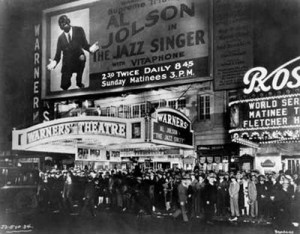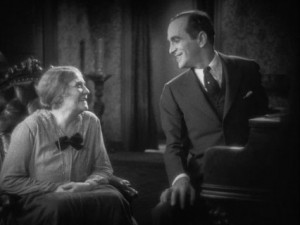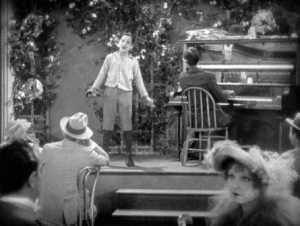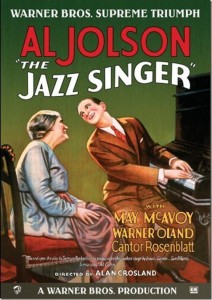See him—and hear him sing!
If you ask anyone what the first talking picture was, they will- hopefully- say The Jazz Singer, with Neil Diamond. Wait, that’s the wrong film. We are talking of course about 1927’s The Jazz Singer, with Al Jolson. What most people don’t realize is that the impact of the film though powerful and wide ranging, didn’t hapen in merely the blink of an eye or two.
Rather, the adoption of sound into the film industry took several years, with the silent era continuing for several years, though by 1930 silent films had become an oddity and most all films were sound. This lag was due to many issues, with increased production cost, competing technologies (like VHS versus betamax), cost of refitting theaters nationwide for the new technology, and studio questions over the public’s desire for sound all playing a role.
Also, not only did all silent films disappear overnight in favor of the new format, but no film was immediately “all sound.” For some time films continued the format which The Jazz Singer began. For as only those who have seen (or researched) the film know, only a few portions of the film have sound and of these, most all are the musical sequences. And to be clear, The Jazz Singer isn’t the first time sound appeared in film, but the first time sound was synchronized to what was happening on the screen.
 In spite of these factors, The Jazz Singer is the film that started us down the road to sound. Because of Jolson’s use of black-face, however (and perhaps the limited sound) it rarely is shown. The film, which simply put is about Jolson’s choice between following his family heritage and becoming the cantor (a post his father now holds) at the local synagogue or using his skills as a entertainer in local jazz clubs. Many folks get hung up on the prevalence of black-face, but race isn’t a theme of the picture at all. It fact it almost seems to take time to avoid falling into what could have been a very stereotypical approach to race – or religion, for that matter. Black-face as outdated and incorrect as it is in today’s world, was then an accepted part of the repertoire. One needs to just accept that for what it is an move on.
In spite of these factors, The Jazz Singer is the film that started us down the road to sound. Because of Jolson’s use of black-face, however (and perhaps the limited sound) it rarely is shown. The film, which simply put is about Jolson’s choice between following his family heritage and becoming the cantor (a post his father now holds) at the local synagogue or using his skills as a entertainer in local jazz clubs. Many folks get hung up on the prevalence of black-face, but race isn’t a theme of the picture at all. It fact it almost seems to take time to avoid falling into what could have been a very stereotypical approach to race – or religion, for that matter. Black-face as outdated and incorrect as it is in today’s world, was then an accepted part of the repertoire. One needs to just accept that for what it is an move on.
Warner Brothers, who kindly provided a review copy of the 2013 blu-ray to us, released a surprisingly good three DVD set a few years ago which revealed a startlingly strong image and a veritable bevy of supplemental material. This year’s transition to high definition is a further upgrade on even that stellar presentation.
 Both audio and video on this release betray their age, but not in any way close to as much as one would expect given that the source material is from 1927. The image is strong with great contrast and nice dark tones, although there are moments where the source material does show damage. The audio is not quite as strong, with only the musical numbers sounding really strong. Still, it is almost hypocritical to be critical of the quality given the age of the elements. And you may have heard that sound was a bit embryonic at that point.
Both audio and video on this release betray their age, but not in any way close to as much as one would expect given that the source material is from 1927. The image is strong with great contrast and nice dark tones, although there are moments where the source material does show damage. The audio is not quite as strong, with only the musical numbers sounding really strong. Still, it is almost hypocritical to be critical of the quality given the age of the elements. And you may have heard that sound was a bit embryonic at that point.
 Suffice to say, there is no way one cannot be amazed by the quality of the feature. And it is much better than 48fps.
Suffice to say, there is no way one cannot be amazed by the quality of the feature. And it is much better than 48fps.
In addition, Warners has ported over almost all of the supplemental material on the previous release. It can be grouped into three basic areas. Materials dealing with the film and the cast itself, which seem to congregate on the same disc as the feature. Additional discs are centered on the history of sound in movies and the Vitaphone process itself, respectively. It is, needless to say, a very deep and pervasive look. Of course we have great commentary tracks and a book as well, all of which are now becoming almost expected from Warners.
The only weakness I found in the release is a personal one, as the third disc, which is comprised of just shy of four hours of Vitaphone shorts. Some of them are interesting and they are definitely a nice historic capsule of the Vitaphone process, which was phased out in 1932. It’s perhaps a bit to much for me- almost exhausting to see them all- but that is just me.
At the end of the day even if you have the earlier three disc set, the upgraded quality of the 2013 release makes purchasing one of the easier decisions of the day. It is a priceless and historic film and surely deserves a spot on your shelf.
The easiest way to get it is from Warner Brothers from their online store at The WB Shop.
